The first step in sizing a system to provide backup electricity is to compile a list of electrical loads for each circuit breaker. Then the circuits that are essential to survival can be identified and the loads added up to determine the required peak power (Watts) and total energy (kWh) used per day. This can be done by direct measurement as described in Electricity Measurements, or the loads can be identified manually by turning off each breaker individually then listing the loads and wattage for each. This is a useful exercise because it will identify those loads which can be easily reduced by, for example, replacing incandescent bulbs with LEDs. Loads such as appliances can be determined by looking up the model number on-line. The energy is calculated by estimating the average time each device is on each day, then multiplying the hours by the wattage in kilowatts (kW = Watts/1000) to get kilowatt hours (kWh). In the following sections, data is shown for our house as an example, but wherever possible, I will show power and energy loads in graphical or tabular form so that solutions for other sized homes can be found.
Normal vs Survival Power and Energy Requirements
Our house has three sub-panels, but only the one in the garage contains the circuits that are considered essential for survival. These include the water pump and purification system and the kitchen – especially the refrigerator. For simplicity only the details for this panel are shown below.
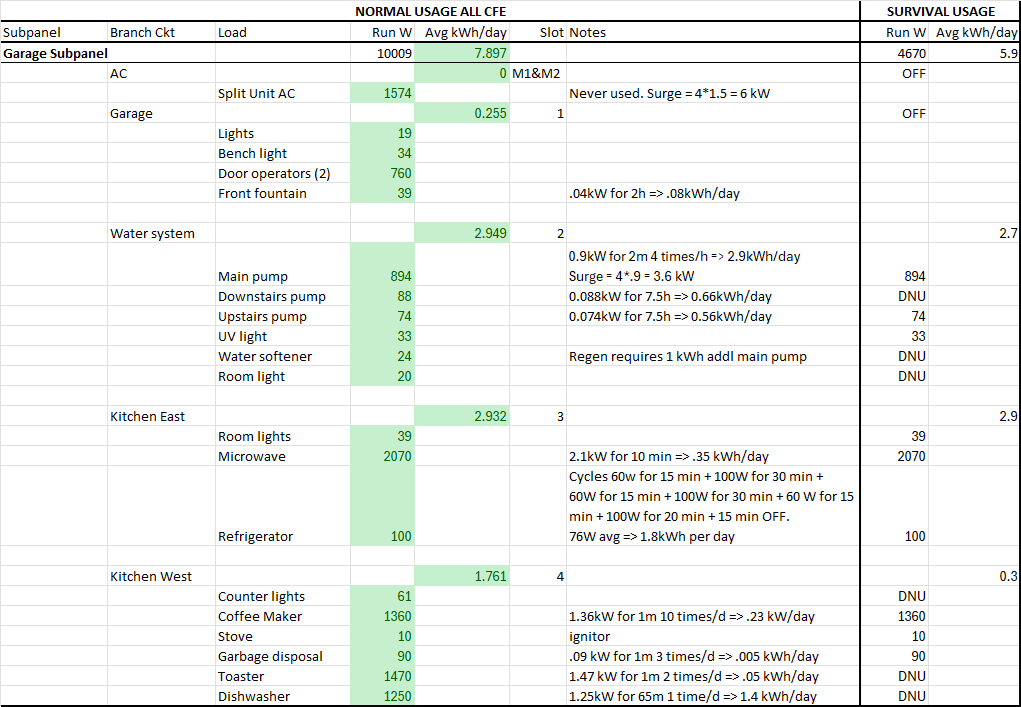
The measured power and energy for normal usage are highlighted in green. For survival, three of the six circuits are set to OFF, and a number of appliances are marked as Do Not Use (DNU). The other two sub-panels are not used at all during backup (survival) mode, but they were similarly measured and totaled to get the total power and energy consumption for the entire house.

The average energy per day works out to 477 kWh per month which agrees with our CFE bills. For survival, a backup supply of 37% of this is needed. Similarly, the maximum power drops from 13.9 to 4.7 kW. Average energy used per day and maximum power determine the sizing of the backup power source and/or battery storage. Although the maximum power is 4.7 kW, the average power is only 0.25 kW. The surge power is 4 times the running power of the main water pump. This is a very short duration surge that occurs when the pump starts.
Three different solutions to providing this backup power are considered below. All three use the above requirements.
Solution #1 – Propane Generator
A typical series of propane (actually dual fuel) generators is the EH series made by DuraMax. The prices shown are from Amazon US. The same generators cost 2 to 3 times as much in Mexico.
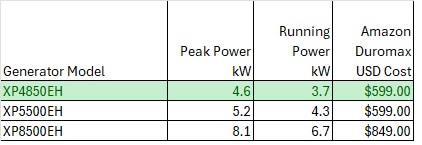
For survival operation, we need a peak power of 4.7 kW and an average or running power of 0.25 kW so the smallest generator listed would work fine, especially if the coffee maker and microwave are not used simultaneously.
There are a number of on-line calculators for propane generators as well as the manufacturer’s data for the running time at half power which can be extrapolated to the required running power. All of these calculations result in about 1.2 gal per day usage at 0.25 kW power.
Portable generators like those listed above are normally used with the small 20 lb (18.9 liter) tanks used on BBQ grills, etc. However, they can be fitted with a quick disconnect fitting that lets them operate from a larger tank such as those normally placed on the roof and used for heating and cooking.
Our original gas tank was 500 liters (132 gal), but propane tanks are never filled beyond 85%, so its storage capacity was 112 gallons. It was replaced by a larger 1000 liter (264 gal) tank (storage capacity 224 gallons) for reasons discussed in the Backup Gas section. Don Pedro sells the 500 liter tank for MXN $13,588 and the 1000 liter tank for MXN $24,173.
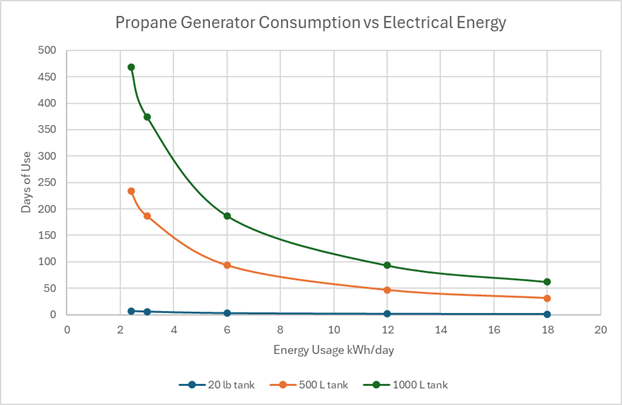
This graph shows that for a 6 kWh per day load, the 1000 liter tank would last 6 months, the 500 liter tank 3 months and the 20 lb tank 3 days.
This is a promising solution, but there are two problems –
- The propane must also be used for heating water and cooking.
- The tank cannot be assumed to be full when disaster strikes.
If the large tank were always filled when it reached half capacity (132 gal), and assuming half the propane were used for cooking and water heating, the expected amount of propane available for the generator would be about (224+132)/4 = 89 gallons. At 1.2 gal per day, this would last about 2-1/2 months.
A disadvantage to this solution is the noise of the generator. Also, these generators are designed for short term use and require periodic maintenance. But they are much less expensive than a solar system and take advantage of the fact that all homes are already equipped with a propane storage system.
A dual fuel, battery start generator Firman #H07552 is sold by Costco Mexico for MXN $17,999 delivered. It has a 120/240VAC output with a peak power of 8.45 kW and a running power of 6.75 kW. This means it has nearly the same capability as the XP8500EX and is about the same price after figuring for taxes and delivery. In addition to providing the same performance as the Duramax generators with the survival load of 0.25kW, it could be used to supply the whole house with an average power of 0.66 kW for a shorter period of time, for the case where the grid power outage is known to be of shorter duration. This is an advantage not available with the solar based system sized for the survival load.
Solution #2 – Propane Generator with Battery
Ecoflow sells an inverter type smart propane generator that is controlled by the Ecoflow Delta Pro battery system. The propane generator is designed to supply the maximum charging power of 1.6 kW to the battery when the charge reaches a preset level and to turn off when the charge reaches another preset. Both of these levels are user controllable, but they would typically be set around 10% and 100%. With the battery initially fully discharged, the charging/discharging profile looks like the graph below. The propane usage is 2.7 gal in 47 hours or 1.3 gal per day – about the same as the propane generator without battery (as would be expected). However, the generator does not run all the time, so the noise is reduced.
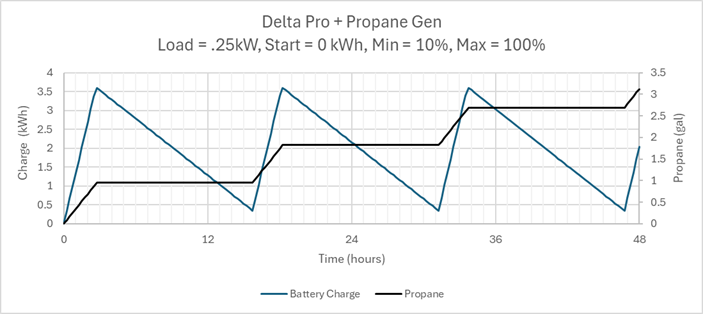
The Ecoflow generator is sold by Powerme in Monterey for MXN $31,000. They also sell the Delta Pro for MXN $69,000, but they may offer a better package price. Costco on line carries the Delta Pro for MXN $63,000.
Point of contact for Powerme is Arturo via WhatsApp +52 81 1749 9475. He is bilingual.
Solution #3 – Solar Power with Battery
It is important to note that this is NOT the usual solar power system which sends power to CFE during the day and draws from CFE at night. Such systems will not provide any backup power in the event of a grid failure.
Battery Storage Requirements
In central Mexico, the sun is more or less overhead for 5 hours or 21% of the day. During this time, the panel provides the energy to the house and also charges the battery for the rest of the day. To be conservative, the battery should store the entire day’s energy of 6.0 kWh. The minimum solar charging requirement for the panels is 6.0 kWh/5h = 1.2 kW.
Inverter/Battery Selection
For a number of factors including portability, cost, and availability in Mexico, the Ecoflow generators were considered. Some of the more promising models are listed below. Prices were obtained from the PowerMe website in Monterrey in August 2025.
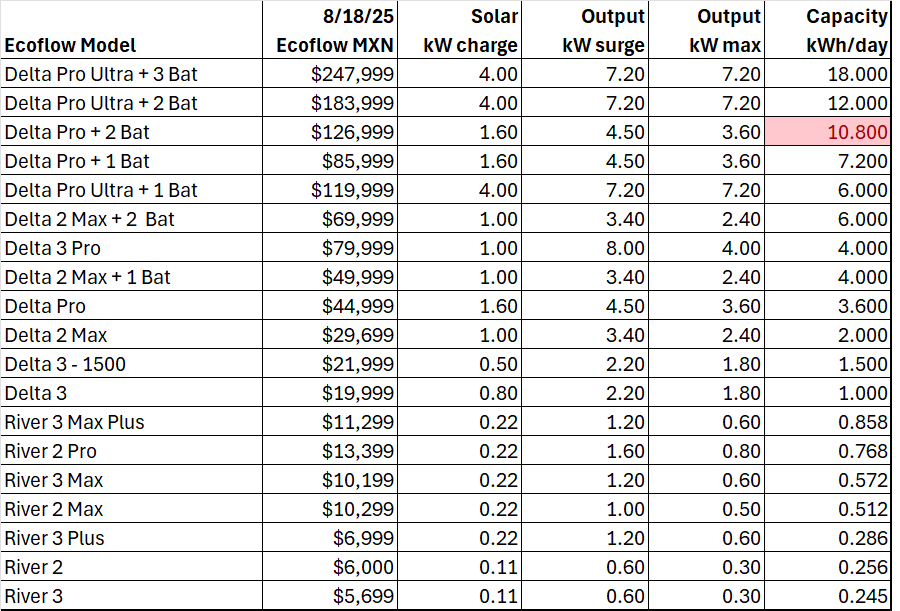
The cell marked in red indicates that while this model has a battery capacity of 10.8 kWh, it will take longer than 5 hours to reach this charge since the charge rate is limited to 1.6 kW by the Delta Pro inverter.
The smallest system meeting the requirements for 6.0 kWh minimum energy storage, 4.7 kW minimum power output, 1.2 kW minimum solar charging power is the Delta Pro Ultra with 1 battery.
Panel Requirements
Solar panels are about 85% efficient. That is, they produce 85% of their rated output when the sun is out and overhead. As mentioned above, in central Mexico, the “solar time” is about 5 hours. This means that for 5 hours every sunny day, the panels produce 85% of their rated output power. So, the rated output of the panels needs to be 1.2 kW/85% = 1.41 kW minimum.
Solar panels have become much more efficient and cheaper in recent years. After consulting with a local solar panel system installer, he recommended two configurations:
| No. of Panels | Panel Power (W) | Total Panel Power (kW) | Installed Price (MXN) |
| 2 | 660 | 1.32 | $22,200 |
| 3 | 660 | 1.98 | $24,700 |
The installed price includes the DC wiring, circuit breakers and surge protectors. Since the price difference between 2 and 3 panels is so small, the 3-panel configuration was assumed. Most solar panel companies do NOT provide off-grid systems such as are needed for long term backup. The point of contact in San Miguel de Allende I found was Michael Lester (Kiwi Mike) whose WhatsApp number is +52 55 8382 0168 or email mexikiwimike@gmail.com. He designs and installs complete systems as well as just the panels.
An experienced solar panel seller will know what size panel you should install for your location given the total panel power output and local conditions for sun angle, cloud cover, etc. This is what I did, and the results were great. But you can also go through a more detailed calculation to determine the panel size and verify the performance of the solar system under different conditions (time of year, cloud cover, load conditions, etc.) See Solar Energy Calculations.
Connection to House Wiring
Whether connected to a sub-panel or the main entry, the backup system MUST be isolated from the CFE wiring using a transfer switch. In my case, the survival circuits are all located in the garage sub-panel, so this panel can be connected to a 6-circuit transfer switch as shown below.
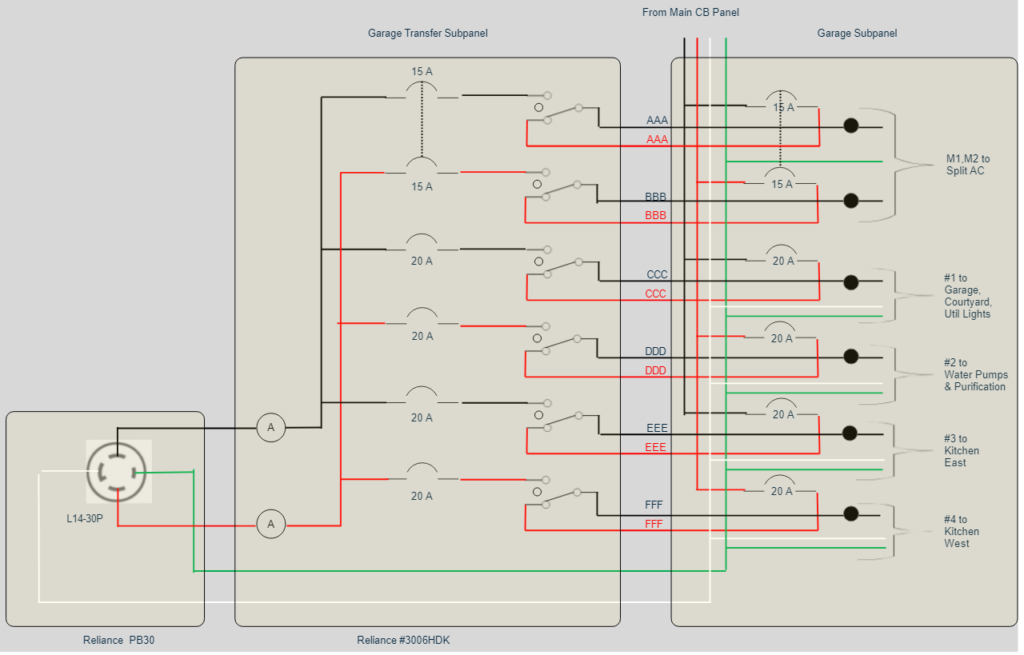
The Reliance 3006HDK is available from Home Depot (US) and also widely discounted by sellers on eBay. A typical price is US $250 so adding shipping and customs fees its cost in MXN is $4,950. It includes the PB30 4-conductor generator plug and a 10 ft 4-conductor AWG10 cord to connect the PB30 to the generator. It is very easy to connect to a sub-panel. My only objection is that it uses a series of circuit breaker that is not so common in Mexico and it comes with (2) 20 A breakers and (4) 15 A breakers which is different from what I wanted as shown in the above figure. But it is easy to order the right sized breakers online and replace them.
The PB30 generator connection should be located close to the sub-panel with a solar backup system, but for use with propane generators it should be outdoors. Liquitite ¾ inch conduit and AWG10 conductors are used to connect the PB30 to the 3006HDK panel. The transfer switch itself should be mounted next to the subpanel in all cases.
In order to test or use the propane generator or the hybrid propane/battery system, it is necessary to physically move the generator outdoors and connect it to the gas connection at least 25 ft from the house. The electrical connection is then made to the PB30 outlet and the appropriate circuits are switched on the transfer switch. The solar system offers a much easier method which allows continuous operation of one or two circuits. The inverter and battery are permanently located in the garage near the transfer switch and sub-panel. The switches on the panel are set for backup power to circuit breaker #3 only and left in this condition. (The remainder of the house runs off of CFE power). In addition to providing continuous verification that the backup system is functioning correctly, this scheme actually reduces the CFE loads by 2.9/15.9 or 18%. That is not a large dollar amount since we were already below the DAC rate, but it provides a greater margin to ensure that we will stay below the DAC.
Cost Comparison
A summary of the total cost estimated for a backup power system providing 6.0 kWh energy per day with peak power of 4.7 kW is shown below. The price difference between a 1000 and 500 liter gas tank is included in the propane systems because the current 500 liter tank was over 15 years old and needed to be replaced anyway.
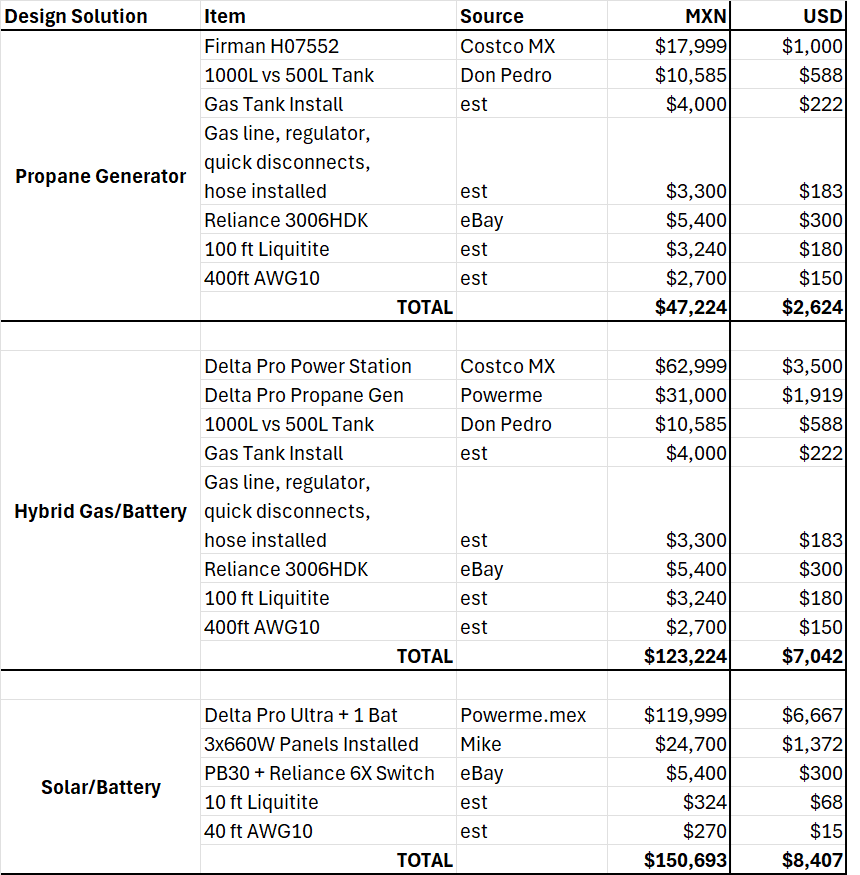
I selected the solar battery system even though it is the most expensive because of its ease of use, facility to monitor continuously, and essentially unlimited operating time (i.e., not limited by propane tank size).
For other solar systems with higher or lower energy requirements, the following figure shows the total system cost vs the daily energy (battery) capacity, which is the main cost driver in solar off-grid systems. Note that for the cost of 2 more batteries, our home could be totally independent of the grid.
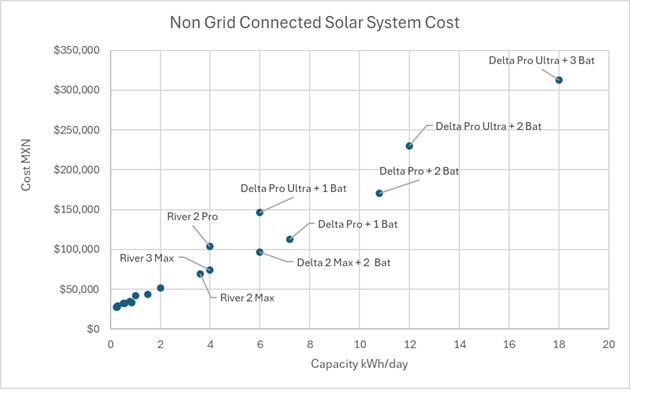
If the cost of these systems is divided by the annual savings in CFE electricity using the “excedente tarifa 2” rate, the years for payoff of the investment can be calculated. It works out to be between 8 and 14. Coincidentally, the life expectancy of the lithium batteries is about 10 years. So they do pay for themselves (barely). However the purpose of the backup system is not to save money but to survive a catastrophic loss of electricity.
Chosen System
As an example of what the selected solar/battery backup system looks like installed, see the home page for a picture of the solar panels, and the following three photos showing the inverter/battery system, the DC surge protector/circuit breaker, and the transfer switch next to the sub-panel.
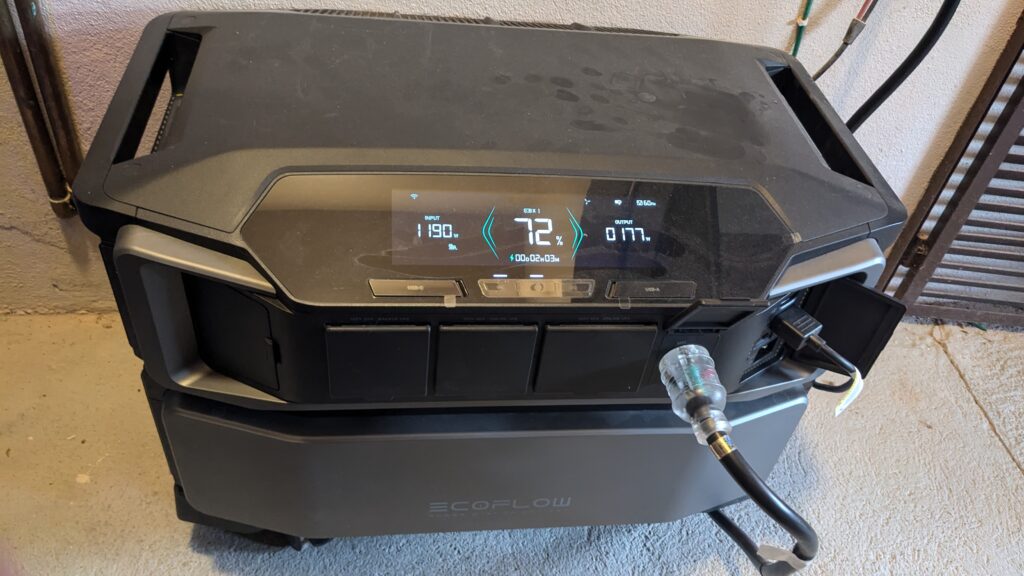
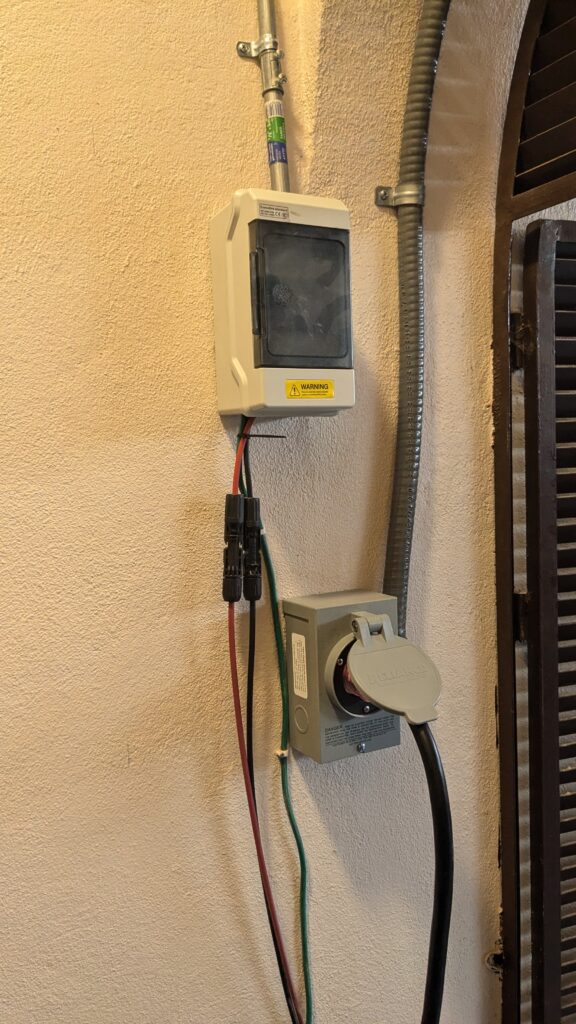
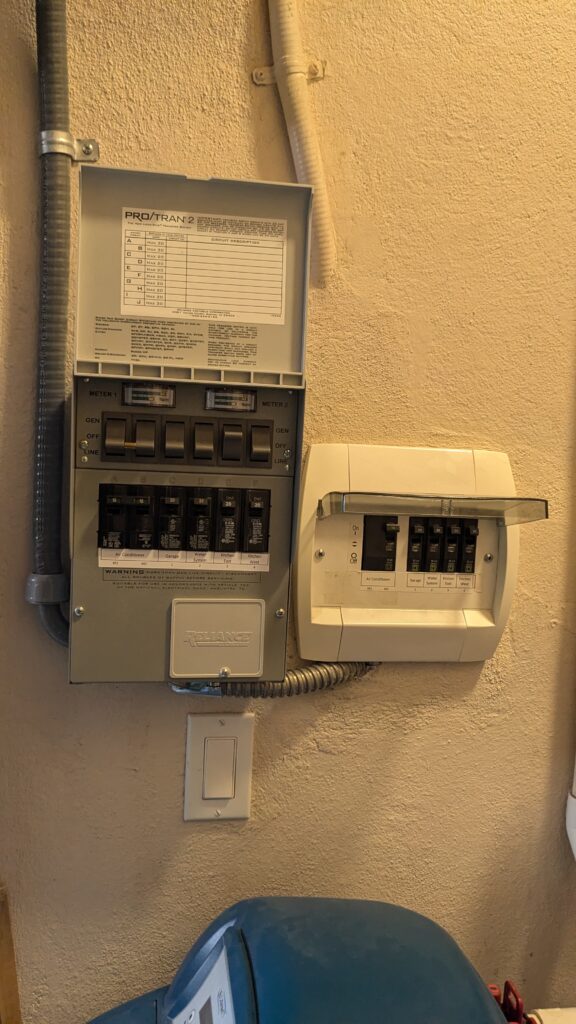
The system works as expected. Originally both the water system and the kitchen East circuit were run from the solar system, but on occasion the battery would discharge over night. This was due to regeneration of the water softener which occurs about every 4 or 5 days. The water softener itself does not use a significant amount of electricity, but the water pump runs during much of the regeneration cycle, and that consumes a lot of energy. During an actual emergency, the water softener would be unplugged so that this does not happen. For now, just the kitchen east circuit runs full time off the solar system.